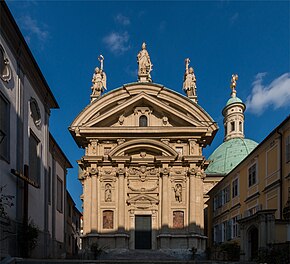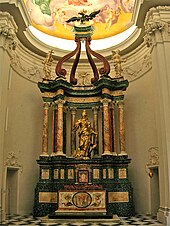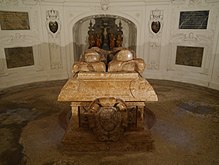Mausoleum of Emperor Ferdinand II (Graz)


The mausoleum of Emperor Ferdinand II next to the Graz Cathedral is a monumental sacral and representative building from the 17th century, which was connected from two different buildings. The complex, begun in 1614 and completed after decades of construction interruptions, in 1714 consists of the Katharinenkirche and the adjoining grave chapel for Emperor Ferdinand II and his family. Together they form one of the most important architectural monuments in Austria from Mannerism , the transition period from the Renaissance to the Baroque .
Building history
Emergence
In 1614 Ferdinand II entrusted his court artist Giovanni Pietro de Pomis (1569–1633), who came from Lodi near Milan in Lombardy, with the design and execution of this monumental tomb, which was completed in 1636.
Ferdinand II decided to build a worthy burial place next to the Graz Cathedral on the area of the former cemetery. The site of a Romanesque cemetery chapel with charnel house , which already existed in 1265 and was consecrated to Saint Catherine, was chosen as the building site. As a painter, architect and builder, Pomis took on the planning and construction management.
Conception
Two sacred buildings with different floor plan and spatial concept were connected for the complex: a church consecrated to St. Catherine of Alexandria and an adjoining oval central building in the south as a burial chapel for Emperor Ferdinand II and his family. In the east around the apse, an enclosing formwork was built around the sacristy and sacristan's apartment, which is crowned by a slender tower.
The conception of the complex shows the ecclesiastical and dynastic representational intentions of the client Ferdinand II .:
- The cross-shaped floor plan of the Katharinenkirche indicates the Christian faith, the oval shape of the burial chapel is a symbol of the resurrection.
- The crowning of the domes of Katharinenkirche and burial chapel in the form of scepter and imperial eagle with imperial sword and imperial orb symbolize the Habsburg dynasty and its claim to power in the empire .
- In the case of the Katharinenkirche, the patronage of St. Catherine of Alexandria not only refers to a medieval predecessor building, but is also in context with the University of Graz founded by Archduke Charles II (the father of Ferdinand II) in 1585 and run by the Jesuit order , which is also under the patronage of St. Catherine of Alexandria (as patroness of the sciences).
- The sandstone figures on the west facade - they depict Saint Catherine flanked by two angels and two people who were converted to the Christian faith by her - and the painted copper panels in the niches with depictions of the lives of the saints not only represent the title saint of the church and University-related program, but also show a counter-Reformation aspect in Porphyrius and Faustina, who were converted to the Christian faith.
Building development
The structure erected under the direction of Giovanni Pietro de Pomis shows strong Italian influences on the building. The oval floor plan with an oval dome of the burial chapel is the first of its kind outside of Italy.
After 1619/20, some changes were made to the complex: alterations to the west facade with the addition of segment and triangular gables, a motif from the Jesuit church Il Gesu in Rome, an increase in storeys on the two side wings and roofing work from 1622. After Giovanni Pietro de Pomis died in 1633 before the completion of the work, Pietro Valnegro took over the construction management in 1633. In 1636, with the help of Antonio Pozzo, the tower in the form of a graceful campanile was completed, in 1637 the roof.
The entire complex was not completed until after the death of Ferdinand II († 1637), because after his election as emperor and the associated move to Vienna, construction work came to a standstill. The crypt altar was consecrated in 1640, after which construction work was temporarily suspended. It was only after the shell had been unfinished for four decades that completion of the building was requested in 1686. Ferdinand's grandson, Emperor Leopold I , commissioned the then still young Graz Baroque master builder Johann Bernhard Fischer to complete the interior and stucco work of the mausoleum. In 1714 the church and six altars were consecrated.
After the Second World War, interior and exterior restorations and measures to repair the dome roof were carried out. Between 1960 and 2010 the complex served as the burial place of the bishops of the Graz-Seckau diocese before it was (again) moved to the Graz Cathedral.
Building description
Katharinenkirche
Exterior construction
The three-storey structure of the Katharinenkirche has a cruciform floor plan with a tambour - dome over the crossing with a crowning cross and angel sputte heads and cartouches under the cornice. The apse are included in the building complex, z. B. the sacristy, presented in a semicircle. A circular, seven-storey tower protrudes in the east apex, which is structured by Ionic pilasters and cornices. The design of the lantern is attributed to Pietro Valnegro ; the dome roof is crowned by a gilded scepter.
A two-storey main floor with Ionic three-quarter columns in front of pilasters stands above the base zone ; Above the attic storey on the central axis there is a segmented gable with an inscribed triangular gable. In the niches of the side axes are iconographic representations from the life of St. Catherine. On the gable is a larger than life sandstone figure of the saint, next to it two angels with martyrs' crowns in their hands. The sculptures are attributed to Sebastian Erlacher and date from 1635/36. The rectangular stone portal with triangular gable has sheet metal fittings with wrought iron fittings (around 1714). An inscription by the builder is attached above. In the east tower is a profiled round arch stone gate.
The building of the Katharinenkirche is structured by bundled Ionic pilasters, in the entablature of the main cornice symbols of the Holy Mass and St. Catherine can be seen, under the cornice angels' heads and on the pilasters of the attic floor relief cartouches, probably formerly painted with coats of arms.
Interior construction
The single-nave nave consists of two bays and barrel vaults. The cross arms are also barrel vaulted. The crossing has a drum dome, supported by bundled Corinthian pilasters. The choir has an apse with a semi-dome. The entablature protrudes strongly and is cranked over the crossing pilasters. Both the nave and the transept have arched windows.
The remarkable stucco work in the Katharinenkirche was carried out in 1688–1689 by Josef Serenio, Girolamo Rossi and Antonio Quadrio. The designs for the stucco decorations of the vaults - with the exception of those in the transept vaults - are attributed to the Graz-born imperial court artist Johann Bernhard Fischer von Erlach , who also provided the design for the Katharinen altar, which serves as the high altar of the Katharinenkirche (1687). The sculptures of the Catherine altar were carved by Marx Schokotnigg (1697–1699); The angel figures of the Marian altar (1697–1701) and personifications of the Christian virtues in the burial chapel for Emperor Ferdinand II are by the same artist. The altar sheet of the Marian altar with the depiction of "Maria Immaculata" was painted in 1699 by Antonio Bellucci.
The frescoes in the nave with the apotheosis of the House of Habsburg that were created at the same time as the stucco decorations were probably painted by Franz Steinpichler. The main focus of the decoration of the nave is on the glorious deeds of Emperor Leopold I. In the center of these frescoes, the liberation of Vienna from the Turks in 1683 is depicted. The nave vault is divided into fields by leaf bar frames, the crossing vault is adorned with cartouches and crowns holding angel pods and imperial busts of rulers from the House of Habsburg.
In the west gallery, angel sputtles hold festoons and a cartouche with the frescoed coat of arms of the noble Dietrichstein family on the parapet . Are on the west wall cherubs with inscriptions cartridge - dated 1689 - to see that the builders Emperor Ferdinand II and Emperor. I. Leopold refer. In the western arched wall of the shield, angel sputtles stretch a drapery, which contains the motto of Emperor Leopold I: "consilio et industria" (German: through advice and diligence [to the goal] ).
Another highlight of the church furnishings is the Holy Grave (1768–1769) by Veit Königer , which is one of the most important “Holy Graves” in Austria due to its many-figured ensemble. But it has only been in the right transept since 1967. The Holy Sepulcher is one of the main works of this late Baroque sculptor and shows a display frame with the figures of Moses, David, Isaias, Jonas, Jeremias and Daniel on the sides. The body of Christ can be seen inside this framework.
Burial chapel

The oval grave chapel with the crypt space below, which contains the graves of the founder and his family, is attached to the southern cross arm of the Katharinenkirche.
In 1960 the burial chapel was converted into the burial place of the bishops of the Graz-Seckau diocese and an altar table was set up. By the end of the 20th century, three bishops, Roman Sebastian Zängerle , Leopold Schuster and Leo Pietsch, found their final resting place in the mausoleum of Emperor Ferdinand II. They were buried in the wall of the burial chapel. After an existing crypt under the Marienkapelle and the Kreuzkapelle had been adapted as a new burial place for the bishops of Graz-Seckau in Graz Cathedral, the deceased bishops were transferred from the mausoleum of Emperor Ferdinand II to this new bishop’s crypt in 2010.
layout
A dome spans the entire burial chapel. The actual grave room for Emperor Ferdinand II and his family is in the basement.
On the dome, frescoes depict the Catholic virtues and deeds of Emperor Ferdinand II as a counter-reformer. They were painted by Matthias Echter around 1689. The fresco in the choir with the mystical marriage of St. Catherine comes from him. The stucco decorations on the dome are said to have been designed by Johann Bernhard Fischer von Erlach. The stucco niche figures represent personifications of Christian virtues (faith, love, hope, justice) and come from Marx Schokotnigg (1695–1696).
The painting “St. Ignatius ”(by Franz Wagenschön, 1766) and“ Maria Immaculata ”(by Josef Tunner, 1858) were once used as altar leaves.
Crypt room
The stucco work in the crypt was made by Mattia Camin around 1640. They were renewed in 1694 by Josef Serenio. The pictorial representations show the rulership insignia and coats of arms of the countries ruled by Emperor Ferdinand II, as well as symbols of death and the sacraments as well as painted scenes from the Old and New Testaments, which point to the resurrection and redemption through Christ.
Double sarcophagus
The double sarcophagus made of red marble, which is now in the middle of the crypt, was intended for the parents of Emperor Ferdinand II. It comes from the former Clariss convent in Paradeis in Graz and was probably made by Sebastian Carlone around 1608. Only Maria von Bayern (1551–1608) is buried in the double sarcophagus; Archduke Karl II (1540–1590), however, has been resting in the Habsburg mausoleum of the Seckau basilica since 1590 . The lid of the double sarcophagus shows the fully plastic reclining figures of Charles II and Maria Anna.
Coffin wall niches
The graves of Emperor Ferdinand II, his wife Maria Anna of Bavaria (1574–1616) and his son Johann Karl (1605–1619), who died early, are laid out as coffin wall niches and marked with inscription panels. The wall niche with the coffin of the emperor is on the left side of the altar, directly above the wall niche with the coffin of his son, who died early. The wall niche below the coffin niche of Maria Anna von Bayern on the right side of the altar remained empty. Ferdinand II died on February 15, 1637 in Vienna and had decreed in his will that he should be buried in Graz.
Herzgrüftl
The so-called Herzgrüftl can be reached from the crypt room of the burial chapel , in which there are still some heart urns . The heart burials of the Habsburgs in Graz once included the hearts of Ferdinand II, his mother Maria of Bavaria , his second wife Eleonora Gonzaga and other archducal family members. The burial niches have been empty since the beginning of the 20th century, and the vessels with the corresponding contents were handed over to the mint in 1910. The separately buried heart and the entrails of Ferdinand II were originally in the same urn, which was initially also kept in the mausoleum. The container was later transferred to Vienna, where it was buried in the royal monastery. At the end of the 18th century, Joseph II had Ferdinand II's entrails buried in St. Stephen's Cathedral and the heart in a new cup in the Loreto Chapel of the Augustinian Church.
meaning
The complex, located in the city center of Graz, was the most important representative building of the imperial court in Graz and its counter-reformation policy . Together with the neighboring cathedral, the castle and the Old University (Jesuit University ) it forms the ensemble of the Graz city crown .
Among the three mausoleums in Styria from the age of the Counter Reformation ( mausoleum for Archduke Karl II. In the basilica Seckau , mausoleum for Ruprecht von Eggenberg in Ehrenhausen , mausoleum for Emperor Ferdinand II. In Graz), the last mausoleum in Graz is taken as A structure of European standing has a supraregional position.
It is one of the most important Mannerist buildings in Austria from the first half of the 17th century. It is the largest mausoleum construction of the Habsburgs . Together with the Graz Cathedral, the building, with its domes and towers visible from afar, shapes the silhouette of the cityscape.
See also
literature
- Alois Kölbl and Wiltraud Resch: Paths to God. The churches and synagogue of Graz. 2nd, expanded and supplemented edition. Styria Verlag, Graz-Vienna 2004, ISBN 3-222-13105-8 , pp. 87-92.
- Horst Schweigert (editing): Graz (for the 850th anniversary of the city) . Dehio-Handbuch, Die Kunstdenkmäler Österreichs, Topographisches Denkmälerinventar. Schroll, Vienna 1979, ISBN 3-7031-0475-9 . Pp. 24-29.
Web links
Individual evidence
- ↑ a b c d e f g h i j k l m Abbreviated from: Der Dom zu Graz ( [1] ), accessed January 11, 2015
- ↑ a b c d e f g h i j k l m n o p q r s Horst Schweigert, Das Mausoleum Kaiser Ferdinand II. ( Online ), accessed January 11, 2015
- ↑ a b c Schweigert: Graz , p. 24
- ↑ a b DasMausoleum, accessed January 11, 2015
- ↑ a b c d e f Schweigert: Graz , p. 25
- ↑ a b Schweigert: Graz , p. 26
- ↑ Last move into the bishop's church - reburial of deceased bishops in the new bishop's crypt , Sunday paper for Styria, issue no .: 07-10, accessed January 11, 2015
- ↑ 400 years of the Capuchin Crypt. Accessed in 2019 . .
Coordinates: 47 ° 4 ′ 17.4 ″ N , 15 ° 26 ′ 33.6 ″ E










